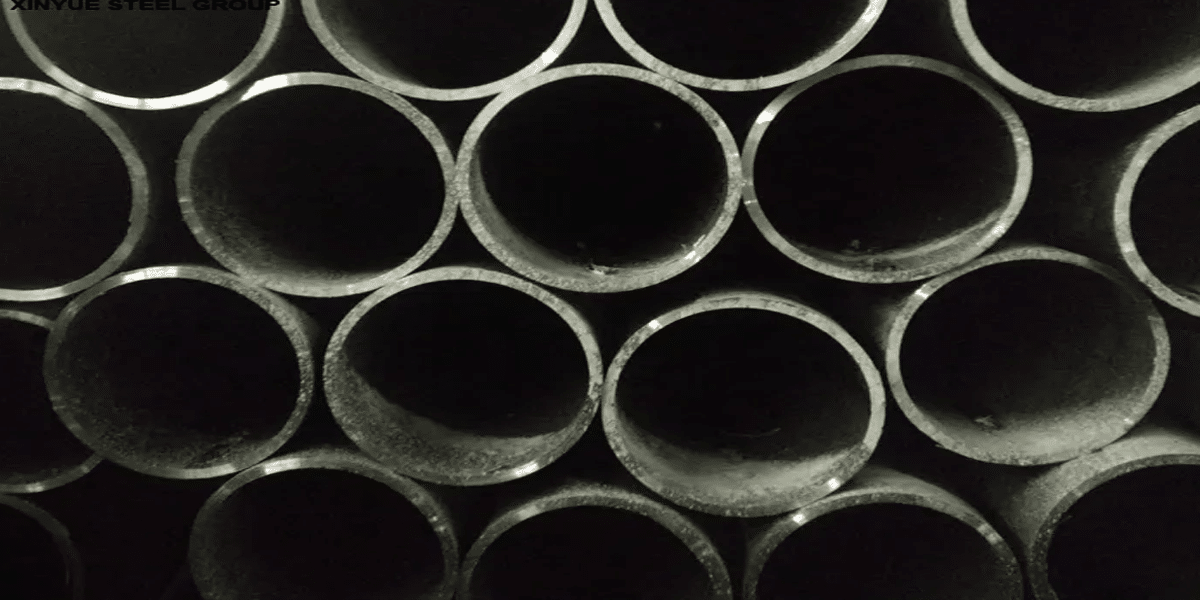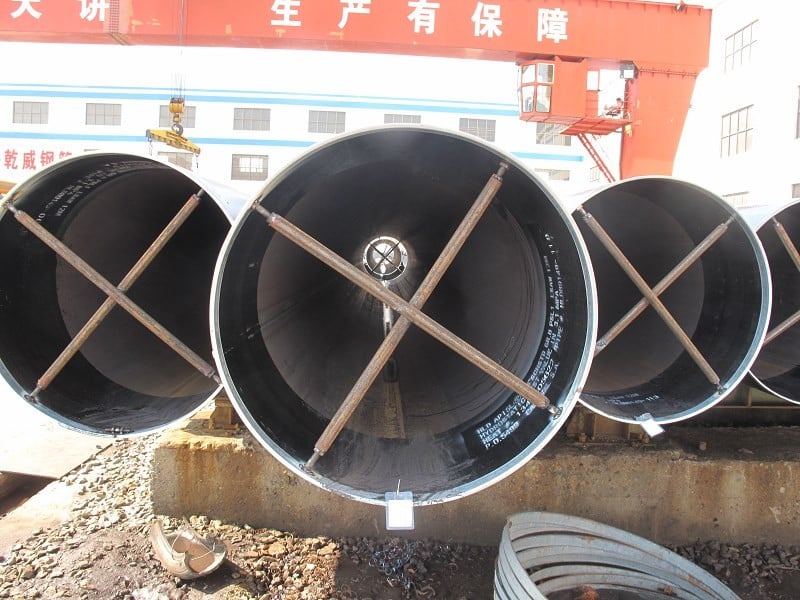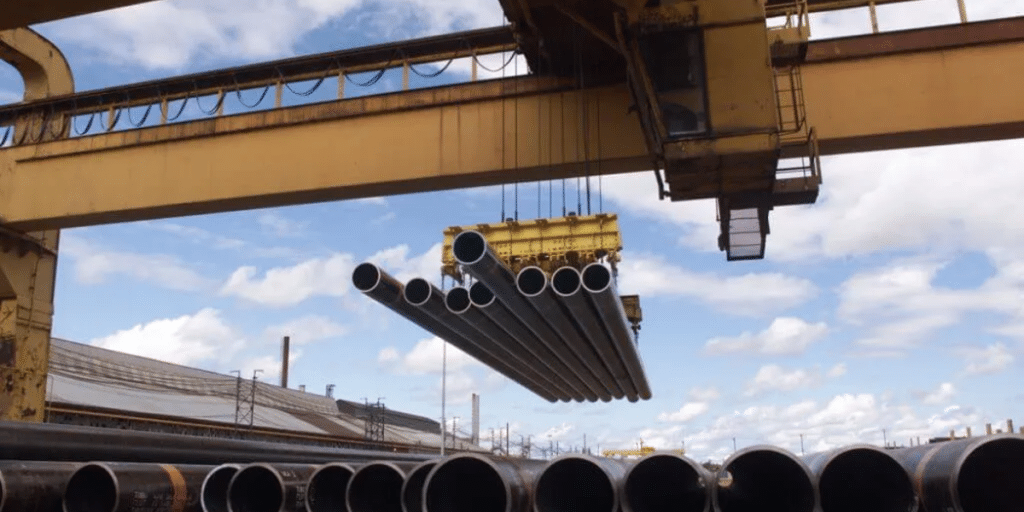- 1. Overview of ASTM A671, A672, and A691 Steel Pipes
- 2. Comparison of Welding Performance of ASTM A671, A672, and A691 Steel Pipes
- 3. Common Welding Methods for ASTM A671, A672, and A691 Steel Pipes
- 4. Common Welding Issues and Solutions
- 5. How to Choose Between ASTM A671, A672, and A691 Steel Pipes?
- 6. Future Trends and Development Directions of ASTM A671, A672, and A691 Steel Pipes
In modern engineering projects, the welding performance of steel pipes plays a critical role in ensuring the strength and stability of structures. Especially in industries such as oil, gas, and chemicals, where high-strength steel pipes are commonly used, selecting the right material and welding process is crucial. ASTM A671, A672, and A691 steel pipes are widely utilized in various industrial applications, yet their welding characteristics vary. This article will delve into the welding properties of these three types of steel pipes, comparing their performance in real-world applications, providing valuable insights to engineers and procurement specialists for making more precise material choices!
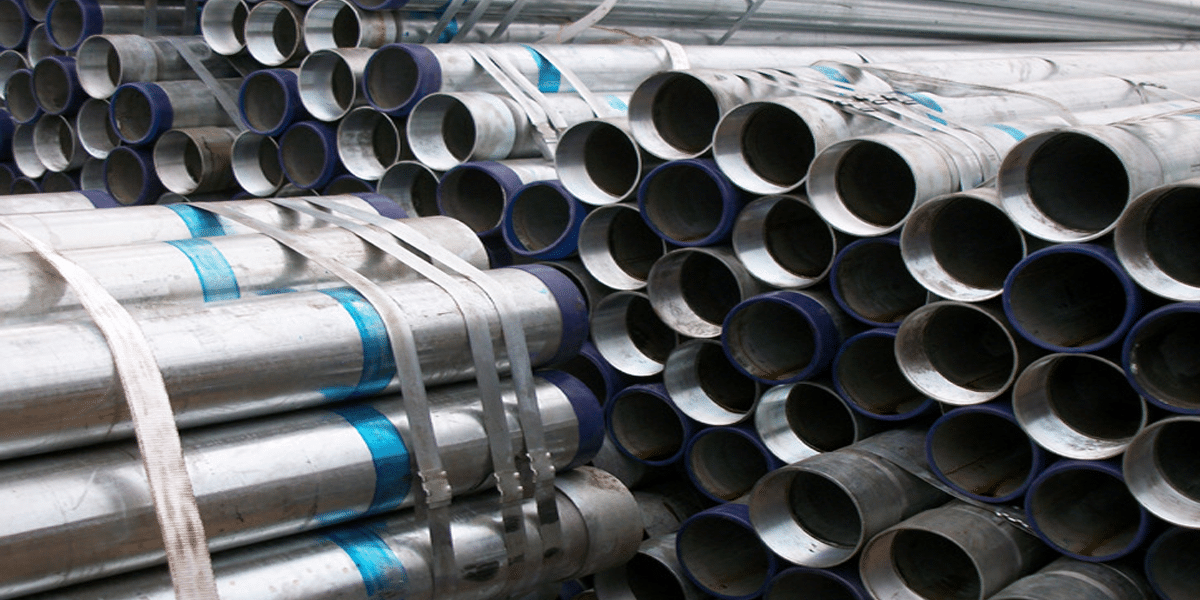
Overview of ASTM A671, A672, and A691 Steel Pipes
ASTM A671, A672, and A691 are three types of high-strength steel pipes commonly used in industries such as oil, gas, and chemicals. These steel pipes are manufactured and used according to the standards set by the American Society for Testing and Materials (ASTM). Each of these pipes has unique characteristics and applications, and understanding these differences is crucial for making accurate material selections.
1. ASTM A671 Steel Pipes: ASTM A671 steel pipes are primarily used in high-temperature and high-pressure environments, particularly in the petrochemical and power industries. They are known for their excellent corrosion resistance and high-temperature endurance, making them ideal for transporting oil, gas, and other corrosive fluids. Made from carbon steel or alloy steel, ASTM A671 pipes are suitable for welding and pressure vessel manufacturing. The standard for A671 pipes requires high mechanical properties and strict control over chemical composition and heat treatment.
2. ASTM A672 Steel Pipes: ASTM A672 steel pipes are also widely used in the oil, gas, and chemical industries, particularly in oil pipeline systems and cross-country transportation projects. Compared to A671 pipes, A672 pipes offer superior crack resistance and improved toughness, making them suitable for large-diameter pipelines. A672 pipes are typically used in low and medium-temperature environments and maintain stable welding performance even under harsh weather conditions.
3. ASTM A691 Steel Pipes: ASTM A691 steel pipes are designed for applications that require the ability to withstand higher pressures and extreme operating conditions, especially in high-pressure oil, gas, and thermal energy pipelines. These pipes are often made from high-grade alloy steel, offering exceptional oxidation resistance and corrosion resistance. A691 pipes have excellent welding performance and are well-suited for more complex working environments, making them widely used in the construction of high-pressure equipment and high-temperature pipelines.

Comparison of Welding Performance of ASTM A671, A672, and A691 Steel Pipes
The welding performance of steel pipes is crucial for ensuring the safety and long-term stability of pipeline systems in industrial applications. ASTM A671, A672, and A691 steel pipes each have unique welding characteristics, and understanding these differences is vital for selecting the right material and optimizing welding processes. Below is a comparison of the welding performance of these three steel pipes:
Welding Performance of ASTM A671 Steel Pipes: ASTM A671 steel pipes, made from low-carbon or alloy steel, are commonly used for transporting oil, gas, and other corrosive fluids. These pipes have good weldability, making them suitable for common welding methods such as manual arc welding, gas shielded welding, and submerged arc welding. During welding, A671 steel pipes maintain their heat treatment properties well, and the strength and toughness of the weld joints are high. However, due to their use in high-temperature and high-pressure environments, it is important to control the welding temperature and cooling rate to avoid cracks in the welded areas.
Welding Performance of ASTM A672 Steel Pipes: ASTM A672 steel pipes exhibit better crack resistance and toughness compared to A671 pipes, making their welding performance superior. They maintain good weld quality in low and medium-temperature conditions. A672 pipes are suitable for various welding methods, including submerged arc welding, gas shielded welding, and tungsten inert gas (TIG) welding. The weld joints in A672 pipes have high strength and can withstand higher pressure and temperature fluctuations. The cooling process after welding is more forgiving compared to A671, making it easier to achieve high-quality welds.
Welding Performance of ASTM A691 Steel Pipes: ASTM A691 steel pipes are designed for high-pressure and extreme operating conditions, requiring more stringent welding performance. Made from alloy steel materials, A691 pipes offer superior oxidation and corrosion resistance. During welding, careful control of heat input and welding parameters is crucial to prevent issues such as hardening in the heat-affected zone (HAZ). Given their higher alloy content, A691 pipes may require specific welding techniques, such as gas shielded welding or submerged arc welding, to ensure the strength and toughness of the welded joints.
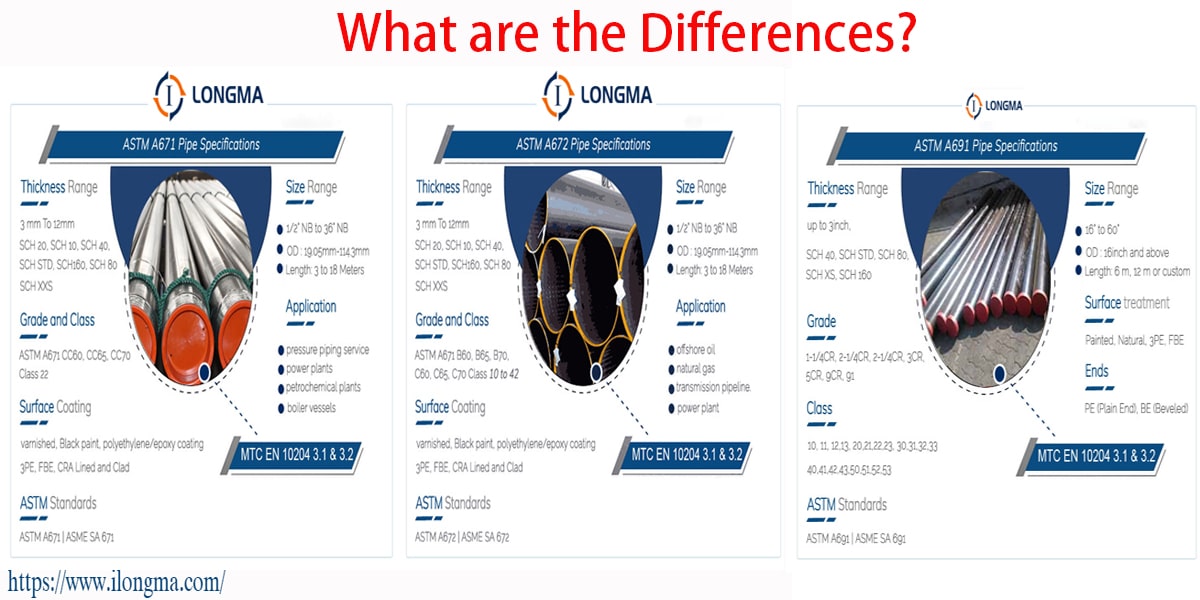
Common Welding Methods for ASTM A671, A672, and A691 Steel Pipes
The welding methods for ASTM A671, A672, and A691 steel pipes depend on their material properties and operating environments. Selecting the appropriate welding process is crucial to ensure the strength, toughness, and long-term reliability of the welded joints. Below are the common welding methods for these three types of steel pipes:
1. Common Welding Methods for ASTM A671 Steel Pipes
ASTM A671 steel pipes are commonly used in high-temperature and high-pressure environments, so the welding methods need to balance strength and heat resistance. Common welding methods include:
Submerged Arc Welding (SAW): Submerged arc welding is suitable for welding thick-walled pipes and provides high-quality welds with fast welding speeds. For A671 steel pipes, this method helps reduce changes in the heat-affected zone (HAZ), ensuring the strength of the welded joints.
Gas Metal Arc Welding (GMAW/MIG): Gas metal arc welding is suitable for welding thinner-walled pipes and offers higher welding efficiency. For A671 steel pipes, this method allows for better control of the welding zone temperature, reducing the risk of cracks.
Shielded Metal Arc Welding (SMAW): Shielded metal arc welding is commonly used for field welding and is suitable for smaller welding projects. When used on A671 steel pipes, careful attention to welding parameters is required to avoid cracks.
2. Common Welding Methods for ASTM A672 Steel Pipes
ASTM A672 steel pipes, known for their superior toughness and crack resistance, are suitable for various welding methods, particularly under low and medium-temperature conditions. Common welding methods include:
Submerged Arc Welding (SAW): A672 steel pipes are ideal for large-diameter and thick-walled pipe welding. Submerged arc welding ensures strong weld joints, especially in high-pressure applications.
Gas Metal Arc Welding (GMAW/MIG): Gas metal arc welding is commonly used for medium-thickness A672 pipes. It offers high welding speed and lower welding temperatures, effectively controlling the heat-affected zone and reducing the occurrence of welding cracks.
Tungsten Inert Gas Welding (TIG): Tungsten inert gas welding is used for precision welding, especially when high-quality weld joints are required for A672 steel pipes. It provides precise control of the welding process, making it ideal for critical pipeline systems.
3. Common Welding Methods for ASTM A691 Steel Pipes
ASTM A691 steel pipes are designed for high-pressure and extreme operating conditions, requiring stricter welding performance. Common welding methods include:
Submerged Arc Welding (SAW): Due to the alloy steel material used in A691 pipes, submerged arc welding offers high welding efficiency and helps minimize the heat-affected zone (HAZ), ensuring strong and tough welded joints.
Gas Metal Arc Welding (GMAW/MIG): Gas metal arc welding is suitable for welding medium-thickness A691 pipes, providing good welding quality and maintaining a lower heat-affected zone, ideal for high-strength alloy steel.
Submerged Arc Automatic Welding (SAW Automatic Welding): In large-diameter A691 steel pipe welding, automated submerged arc welding improves welding speed and ensures consistent weld quality, reducing human error and welding defects.
Common Welding Issues and Solutions
1. Weld Cracking
Issue Description: Weld cracking is one of the most common defects, typically occurring in the weld zone or heat-affected zone (HAZ). Cracking can result from high cooling rates, excessive heat input, or stress concentration in the weld.Solutions:
Control Cooling Rate: Properly control the cooling speed after welding to prevent rapid cooling, which may lead to cracks.
Adjust Welding Parameters: Ensure optimal welding current, speed, and sequence to avoid stress concentration and potential cracks.
Preheat and Post-heat Treatment: Apply preheating or post-heating treatments to reduce thermal stresses and minimize the risk of cracking.
2. Porosity
Issue Description: Porosity refers to the presence of small holes in the weld, typically caused by trapped gases (such as hydrogen, oxygen, or water vapor). Porosity can compromise the strength of the weld, leading to potential corrosion or failure of the pipe.Solutions:
Use Low-Hydrogen Electrodes: Employ low-hydrogen electrodes to prevent hydrogen-induced porosity.
Clean the Welding Surface: Ensure that the surface of the pipe is free from oils, moisture, and oxides before welding to prevent gas entrapment.
Adjust Welding Parameters: Ensure stable welding current and voltage to minimize the amount of trapped gas in the weld.
3. Inclusions
Issue Description: Inclusions refer to weld defects where slag or other impurities are trapped in the weld. These defects can weaken the welded joint, making the pipe more susceptible to failure.Solutions:
Clean Weld Surface Regularly: Clean the weld surface after each layer of welding to remove slag and impurities.
Control Welding Parameters: Adjust the welding speed and current to ensure that slag and impurities can escape during the welding process.
Use Correct Welding Technique: Employ the appropriate welding method, such as manual arc welding or gas-shielded welding, to minimize the risk of inclusions.
4. Lack of Fusion
Issue Description: Lack of fusion occurs when the base material and the weld do not fully melt together, typically at the edges or corners of the weld. This defect reduces the strength of the weld and may lead to leakage.Solutions:
Ensure Adequate Heat Input: Adjust welding current and speed to ensure sufficient heat to melt the material properly.
Adjust Welding Angle and Position: Ensure proper electrode or welding gun angle to achieve complete fusion of the weld and base material.
Weld Sequence Optimization: Plan the welding sequence to avoid excessive temperature variations that could cause lack of fusion.
5. Excessive Hardening in the Heat-Affected Zone (HAZ)
Issue Description: High temperatures during welding can cause hardening in the heat-affected zone, which may increase brittleness and reduce resistance to cracking, especially in high-alloy steels.Solutions:
Control Heat Input: Adjust welding parameters, such as current, voltage, and speed, to minimize excessive heat input and reduce the hardness of the HAZ.
Post-Weld Heat Treatment: Apply appropriate post-weld heat treatment (PWHT) to reduce the hardness of the HAZ and improve toughness.
Select Appropriate Welding Method: Use welding methods that minimize heat input and reduce the impact on the HAZ, such as low-heat-input welding processes.
6. Welding Distortion
Issue Description: Welding distortion occurs due to the thermal expansion and contraction of the steel during the welding process. This can cause dimensional inaccuracies and misalignment of the pipeline.Solutions:
Optimize Welding Sequence: Plan the welding sequence carefully to reduce stress concentration and minimize distortion.
Preheat and Use Fixtures: Preheat the steel pipes before welding and use fixtures to secure them during the process to minimize distortion.
Control Welding Temperature: Avoid excessive welding temperatures that could cause significant thermal expansion and distortion.
7. Inadequate Weld Strength
Issue Description: Inadequate weld strength can result in weak joints, leading to failure or leakage in the pipeline system.Solutions:
Use Suitable Welding Materials: Choose appropriate welding materials that match the steel grade and environmental conditions to ensure adequate joint strength.
Quality Control: Strictly monitor all aspects of the welding process, including welding parameters, techniques, and post-weld inspections, to ensure weld quality meets the required standards.
How to Choose Between ASTM A671, A672, and A691 Steel Pipes?
1. Application Field
ASTM A671 Steel Pipe: Typically used for large-diameter pipes in applications such as pressure pipelines, oil and gas transmission systems, and chemical pipelines. This pipe offers excellent weldability and is suitable for high-pressure environments.
ASTM A672 Steel Pipe: Commonly used in water, oil, and gas transportation systems, particularly in low-temperature environments. A672 steel pipe provides high tensile strength, making it suitable for high-pressure and high-temperature applications.
ASTM A691 Steel Pipe: Used in more demanding pressure conditions and harsher working environments, especially in power plants, petrochemical industries, and high-temperature, high-pressure applications. A691 steel pipe offers enhanced corrosion resistance and high-temperature durability.
2. Material and Alloy Composition
ASTM A671: Typically made from low-alloy or carbon steel, this pipe is suitable for milder operating conditions. It allows for the use of various welding materials to accommodate different pressure and environmental needs.
ASTM A672: Made from low-alloy or alloy steel, A672 provides superior high-temperature and corrosion resistance, making it suitable for more rigorous applications.
ASTM A691: Made from high-alloy steel, A691 pipes are used in more extreme working conditions, with greater resistance to corrosion and higher operational temperatures.
3. Environmental Conditions
High-Temperature Environments: For applications in high-temperature environments, such as power plant boilers or petrochemical processes, ASTM A691 is a better choice due to its resistance to high temperatures and oxidation.
Low-Temperature Environments: ASTM A672 steel pipes are better suited for low-temperature conditions, offering excellent low-temperature performance.
Corrosive Environments: When used in corrosive environments (such as seawater or chemicals), ASTM A691 pipes are ideal due to their superior corrosion resistance.
4. Welding Performance
ASTM A671: This pipe offers good weldability and is commonly used for welding large-diameter pipelines, ensuring long-term operational stability.
ASTM A672: While it has good welding performance, it requires more stringent welding techniques and material selection to meet higher performance demands.
ASTM A691: Though it has good welding performance, due to its high-alloy content, special attention should be paid to the welding process to prevent defects from high temperatures.
5. Pressure Rating
ASTM A671 and ASTM A672 are suitable for medium-pressure working conditions, making them ideal for most oil, gas, and chemical transportation systems.
ASTM A691 is designed to withstand higher pressures and more extreme operational conditions, making it ideal for high-pressure, demanding environments.
6. Cost and Budget
ASTM A671 steel pipes are generally more cost-effective and suitable for projects with tight budgets.
ASTM A672 and ASTM A691 pipes have higher costs due to their superior material composition and higher performance specifications, making them more suitable for projects with demanding operational requirements.
7. Standards and Certification
Ensure that the chosen steel pipes meet the relevant ASTM standards and come with proper certifications or quality inspection reports. Different standards will provide varying chemical compositions, mechanical properties, and dimensional requirements, so it’s important to verify the specifications.
8. Manufacturer and Supplier Selection
Choose reliable, ASTM-certified pipe manufacturers and suppliers to ensure that the pipes meet the required standards. It’s also essential to choose manufacturers that provide after-sales support and can assist with potential issues.
Future Trends and Development Directions of ASTM A671, A672, and A691 Steel Pipes
1. Increased Demand for High-Performance Materials
As industries face more extreme operating conditions, there will be an increased demand for steel pipes that can withstand higher temperatures, pressures, and corrosive environments. ASTM A691, with its high-alloy composition, will be in higher demand for applications requiring enhanced corrosion resistance and durability at high temperatures. Additionally, pipes that meet stringent environmental standards (such as those in the energy, petrochemical, and marine industries) will see more widespread use.
Trend: Greater emphasis on high-alloy materials and advanced coatings for corrosion resistance, especially for harsh environments like offshore oil rigs, power plants, and chemical processing plants.
2. Focus on Sustainability and Eco-Friendly Materials
As sustainability becomes a critical issue globally, the steel pipe industry will increasingly focus on reducing its environmental footprint. This includes the development of pipes made from recycled materials, more energy-efficient production processes, and pipes that help reduce energy consumption during transportation. ASTM A671, A672, and A691 pipes will likely be produced with improved materials that offer both enhanced performance and lower environmental impact.
Trend: The introduction of eco-friendly production methods and the use of recycled materials will be a major focus for manufacturers to meet industry sustainability goals.
3. Improved Manufacturing Technologies
The development of advanced manufacturing technologies, such as additive manufacturing (3D printing), automated welding techniques, and precision fabrication, will contribute to the production of high-quality steel pipes with better consistency and performance. These technologies can improve weld quality, reduce material waste, and enhance the overall efficiency of the manufacturing process.
Trend: The integration of Industry 4.0 technologies in the steel pipe production process, including automation, AI-based quality control, and real-time monitoring of manufacturing processes.
4. Enhanced Corrosion Resistance
With an increasing focus on long-term reliability and cost-effectiveness, corrosion resistance will remain a key development area. The use of advanced alloying elements, such as nickel, chromium, and molybdenum, will be enhanced in materials like ASTM A691, and coatings such as fusion-bonded epoxy or superalloy coatings will become more prevalent.
Trend: Increasing use of superalloys and specialized coatings for enhancing the durability and lifespan of steel pipes in highly corrosive environments, such as deep-sea oil exploration, offshore infrastructure, and chemical plants.
5. Smarter and More Durable Infrastructure
As infrastructure demands grow globally, especially in developing economies, there will be a demand for smarter, more durable pipes that can monitor and report on their condition. Smart piping systems integrated with sensors and communication devices could become a trend, helping with predictive maintenance, leak detection, and environmental monitoring.
Trend: Smart steel pipes integrated with sensors for real-time monitoring of structural integrity and performance, which can reduce maintenance costs and improve safety.
6. Cost Reduction and Efficiency
The continued push for lower costs in the face of increased demand for high-performance materials will push manufacturers toward more cost-effective production methods. Innovations in material sourcing, welding techniques, and automation will make high-quality pipes like ASTM A671, A672, and A691 more affordable, while maintaining or improving performance characteristics.
Trend: Adoption of lean manufacturing principles and cost-effective production processes, such as advanced welding technologies and automated inspections to reduce labor and material costs.
7. Global Expansion of Applications
As emerging markets expand, especially in Asia, Africa, and South America, there will be increased demand for steel pipes in infrastructure projects, energy production, and industrial applications. ASTM A671, A672, and A691 pipes will be critical in supporting the growth of energy infrastructure, such as natural gas and oil pipelines, and water transportation systems.
Trend: Growth in infrastructure development in emerging markets, leading to an increased demand for high-performance steel pipes in sectors like water treatment, oil and gas, and power generation.
8. Enhanced Pipe Inspection and Quality Control
The quality and safety of steel pipes are of paramount importance, particularly in applications where high pressure and temperature conditions are involved. The use of non-destructive testing (NDT), ultrasonic testing, and automated inspection systems will continue to improve the quality control process, ensuring that ASTM A671, A672, and A691 pipes meet stringent standards.
Trend: Widespread use of automated inspection technologies (such as AI-based defect detection) to ensure higher levels of precision and safety in steel pipe manufacturing and welding.
9. Customization and Tailored Solutions
As industries increasingly require specialized solutions to meet unique project demands, there will be a greater focus on customized steel pipes that meet specific material, pressure, temperature, and environmental needs. Manufacturers will offer more tailored solutions for various sectors, including energy, transportation, and water treatment.
Trend: The rise of customized steel pipe solutions for highly specialized industries, including tailored alloy compositions and size specifications to meet unique project requirements.
As industries continue to evolve and face increasingly challenging operational conditions, the demand for high-performance materials like ASTM A671, A672, and A691 steel pipes will only grow. These pipes offer unique advantages in terms of strength, durability, and resistance to corrosion and extreme temperatures, making them critical in applications ranging from oil and gas to water treatment and power generation. Looking ahead, innovations in manufacturing technologies, material compositions, and smart infrastructure will further enhance the performance and efficiency of these pipes. By staying aligned with these trends and advancements, companies can ensure that they select the best materials for their projects, guaranteeing long-term reliability and cost-effectiveness. Ultimately, the future of ASTM A671, A672, and A691 steel pipes will be marked by greater customization, sustainability, and technological integration, meeting the ever-evolving demands of modern industries!

